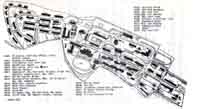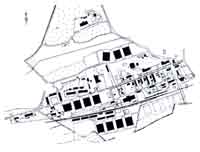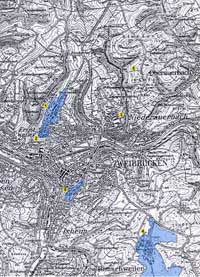Here with details about Kreuzberg Kaserne. Note the absence of any mention
of the 6901st.
SOURCE
U.S.
ARMY INSTALLATIONS - ZWEIBRÜCKEN
|
| |
|

|
| MAPS |
| Installation
Maps - late 1970s |

1.
Kreuzberg Kaserne, late 1970s (179 KB)
|

2. Miesau
Army Depot, late 1970s (85 KB)
|
|
|
|
|

|
1970s
Topographical map of Zweibrücken and
surrounding area. Probably around the late 1960s.
Legend:
1. Kreuzberg Kaserne
2. Family Housing Area
3. Niederauerbach Kaserne
4. Zweibrücken Air Base
5. Oberauerbach Local Training Area
6. Weisse Kaserne
Click on the thumbnail to view a larger
format of the same map.
|
 Zweibrücken
(KB)
Zweibrücken
(KB)
|
|
|
| PHOTOS |
| Click on thumbnail
to view larger image |
| |
|

|
| HISTORIES &
MISC. INFORMATION |
| |
| (Source: ACS
Welcome Packet, early 1980s) |
The History of
Kreuzberg Kaserne
In 1937/38 it became inevitable that a kaserne be built on the Kreuzberg,
which was destined for armored engineer (pionier) troops. The first four
buildings (Bldg 4000, 4001, 4002 and 4003) were designed for storing
heavy equipment. In 1940, construction was completed and the Engineer
chief of staff and his personnel moved in temporarily.
In 18 March 1945, Zweibruecken was occupied by American Troops. Three
months later, by the end of June 1945, the French Garrison took over the
kaserne. The four buildings were restored and named Turenne
Kaserne. In 1953 the French Garrison was transferred to
Niederauerbach Kaserne and in turn Kreuzberg was restored and enlarged
by American troops. After completion of the project, Kreuzberg Kaserne
became the Personnel Replacement Center of
the U.S. Army Europe.
In 1957 additional buildings were erected and the first Bundeswehr unit,
the 914th Transportation Battalion, moved in. In February 1959, the
Transportation Battalion was transferred to Niederauerbach Kaserne and
the 931st Transportation Battalion moved into the German part of
Kreuzberg Kaserne.
In 1960 Kreuzberg Kaserne was entirely turned over to US troops. With
the forced withdrawal of US troops stationed in France in 1967, the Supply
and Maintenance Agency moved into Kreuzberg Kaserne. This
installation operated the first logistic computer system in USAREUR. In
NATO this system was nick-named "Moby Dick." (Webmaster
Note: Actual designation - "MOBIDIC", see Basil Hobar's
Personal Recollections on the ComZ
Europe Page.) This unit gradually became the Supply Center
for the US troops stationed in Europe and has been extended step by
step. |
| |
  For more on the Replacement Depot, see "Replacement
System, 1945-1963."
For more on the Replacement Depot, see "Replacement
System, 1945-1963."
  For more on the Supply and Maintenance Agency, see "US
Army Materiel Management Agency, Europe."
For more on the Supply and Maintenance Agency, see "US
Army Materiel Management Agency, Europe." |
|

|
|
 |
| Kreuzberg Past
and Present, By
Sp4 Charles Powers and Monika Kropf, March 15, 1988 |
Kreuzberg
Kaserne straddles the highest hill overlooking Zweibrücken,
West Germany, and has served as an important military location
for many years. The name "Kreuzberg" comes from "Kreuz"
(cross) and "berg" (mountain). During the Middle Ages
a cross used to stand along the path going up the hill to
Landstuhl and people referred to the hill as "the mountain
with a cross."
The height of the hill (1,121 ft) allowed it to be used to
attack Zweibrucken throughout the city's history, but it was not
until the building of the "Westwall" by Hitler during
WWII that a permanent military camp was set up on Kreuzberg. By
1938 the kaserne housed a German 3rd Reich motorized artillery
unit. The present day buildings 4000, 4001, 4003 and 4004 were
troop barracks and administrative buildings. Building 4002 was a
dining hall and 4010 was a parking and maintenance area for
vehicles and artillery pieces.
After Hitler's defeat, the buildings housed American soldiers
until the kaserne was turned over to the French Army. In the
early 1950's the Americans returned, expanded the installation
and used it as a personnel replacement center for the U.S. Army
in Europe. In the mid 1960's the kaserne was renamed "Kreuzberg
Kaserne" and at that time took its present day shape.
Today Kreuzberg Kaserne houses a diverse group of military
units, but its importance as a military installation is as great
as ever. In the kaserne are several organizations that affect
people throughout Europe with activities as diverse as supplying
groceries for the local commissary to providing logistical
sustainability for U.S. forces in the European theater during a
time of war. |
|
The
60th Ordnance Group
The 60th Ordnance Group began operations during WWII where it
served with honor in the European theater. Since then it served
with distinction in Korea and in Vietnam, earning a total of 15
battle streamers and one unit meritorious commendation.
From 1972 to present the Group has been based in Zweibrücken,
just outside the gates of Kreuzberg Kaserne. It is unique in
that it is the only conventional ammunition group in the Army.
According to CSM Isaac M. Clifton, the 60th Ordnance Group is
composed of three ordnance battallions, two Explosive Ordnance
Detachment Control Centers, and one ammunition depot located in
Miesau.
"We operate under the hybrid ammunition company
concept," he said, "and we have the capability to
receive, transport, store, issue and ship ammunition via a
terminal transfer company and 31 separate storage sites
scattered throughout Europe."
"The Group controls two-thirds of the conventional
ammunition stock in USAREUR," he added. In addition, the
Miesau Army Depot has a maintenance mission that on the average
occours a $1 maintenance cost versus $68 replacement cost. The
6901st Civilian Support Center at the Depot also runs the
Ammunition Handler and Security School for the 60th Ord Group.
"A majority of our personnel are not miltary," said
Clifton. "Over half are DA civilians, U.S. family members,
local nationals, and civilian support personnel." |
|
|
Information
Systems Engineering Command
"Developing solutions to Army problems USAREUR-wide
is our mission", said Maj. Stephan C. Lewis, U.S.
Information System Engineering Command-Europe (ISEC-EUR).
ISEC-EUR, formerly Computer System Command, works hand-in-hand
with the 5th Signal Command, Worms, as a European theater asset
providing computer engineering services. It is a technical
resource element whose system analysts have three major
missions:
First, to provide software maintenance support for all Army
Standard Army Management Information System (STAMIS). Second, to
develop software for USAREUR Standard Systems. Lastly, to
provide technical consultation reviews for computer systems
ranging from micro to mainframe systems.
"At any one time 25% to 30% of our organization is TDY in
the customer service support role we provide throughout the
theater," Lewis said. "Our customers are USAREUR-level
organizations with problems that are theater-wide."
"One example of a software system we have developed is the
Inland Movement of POVs System. It forms the backbone of the new
POV inland shipping program begun just recently that saves time
and money for all USAREUR soldiers and civilians."
"We like to think of ourselves as a technical neighbor that
provides a bridge between the national computer industry and the
Army within the European theater," he said.
517th Maintenance Battalion
The 517th Maintenance Battalion is only one of two such
battalions of its kind in the world. Along with its sister
battalion, the 74th Maint Bn, Korea, it is responsible for the
calibration and repair of Test, Measurement and Diagnostic
Equipment (TMDE) in its theater of operation. |
|
The
517th is divided into three companies located in Germany; each
one operates a "secondary reference Iab." The three
companies operate 45 "downloaded" mobile transfer
teams that serve customers throughout Germany and other European
countries, including Italy, Greece, Turkey and the Sinai
Peacekeeping forces.
"Not only do we support Army customers, we service Air
Force, Navy and NATO forces", said Lt. Col. David A. Dull,
Commander, 517th Maint Bn. "We are responsible for 180,000
pieces of equipment from 3000 customers worth $35,000,000,"
he said.
"Our "downloaded" mobile transfer units are
primarily fixed facilities that can become mobile upon
notification. Their job is to take equipment from customers and
compare it to a known standard. If it deviates, we adjust, or
calibrate it. If it requires repair we have the facilities for
repair. On the average, for every 5 pieces, one is
repaired."
"We maintain traceability to the National Bureau of
Standards," he said. "Our mobile unit standards are
checked with our secondary reference lab standards, which are
compared to the primary standards in Huntsville, Ala, which are
in turn calibrated by the National Bureau of Standards."
"Our company commanders have one of the hardest missions in
the Army, because they are responsible for so much over such a
large theater", Dull said. "They must rely on their
NCOs, who in turn rely upon the young soldiers. The young
soldiers really deserve much of the credit."
200th TAMMC
The 200th Theater Army Materiel Management Center (200th TAMMC),
is the nerve center for European theater supply and maintenance.
Its mission is to keep USAREUR logistically ready to fight, to
improve the logistical readiness of USAREUR during, peace time
and provide logistical sustainablity for U.S. forces in war.
Three objectives contribute to accomplish the mission: to assess
and report the logistic readiness of |
|
|
USAREUR
forces, to manage the logistics aspects of USAREUR force
modernization and to sustain forces already deployed, as well as
reinforcements, through a war reserves program. These tasks are
managed, by six directorates.
• "The Directorate for Plans, Readiness,
and Support Operations (DPRSO) is the principle advisor and
expediter for the theater on foreign military sales when USAREUR
is the source of support," said Thomas Korczynski, Deputy
Chief. "During war, we fill logistics assistance requests
through the NATO mutual support agreement."
In addition to logistical readiness, DPRSO manages the Theater
War Reserves. The accountability officer in DPRSO manages an
inventory of theater stocks valued in excess of seven billion
dollars and is also accountable for over 260 million dollars of
U.S. owned equipment provided to German Army reserves for
Wartime Host Nation Support of U.S. Forces.
"We organize USAREUR participation in the CINCUSAREUR and
Chief of Staff of the Army supply and maintenance award for
excellence programs," said Korczynski. "These programs
are intended to prevent fraud, waste, and abuse and to provide
command recognition for unit meritorious supply and maintenance
achievements," he said.
• According to SGM Thomas A. Ricker, the Directorate
for Materiel, (D/MAT), is the management and control center
for selected critical items required to enhance the readiness
and support of U.S. and other designated NATO forces.
"These items include all classes of supply except medical,
ammunition, missiles and bulk petroleum," he said.
• The Directorate for Missiles and Munitions (DMM)
manages ammunition, major end items and repair parts.
"These assets are valued in excess of nine billion dollars
and are stored in more than 4500 storage structures thourghout
USAREUR," said SGM Michael D. Richter. |
|
"Our
objective is to increase stockpile size, and reduce the quantity
of unserviceable ammunition," he said. "We further
plan for new equipment fieldings such as PATRIOT, and product
improvements on existing missile system."
• According to Col. Ronald V. Bila, the Directorate
of Bulk Fuels (DBF) manages the U.S. owned, French
contractor operated, Donges-Metz Pipeline System, a 627
kilometer multiproduct line capable of pumping 110,000 gallons
per hour. DBF is the theater manager for bulk fuel storage and
distribution in Central Europe.
It supports the U.S. Army, Air Force, and Canadian Forces,"
Bila said. "On a yearly basis this consists of over 900
million gallons of fuel and 260 thousand metric tons of
coal." DBF accomplishes its mission through four distinct
systems: pipeline distribution, coal distribution, commercial
leased storage, and ground transport.
• The Directorate for Resource Management, (DRM),
manages both financial and manpower resources. DRM directs the
execution of finance and accounting program and budget, stock
fund budget, management analysis, and manpower functions. It
also processes commercial contractor payments of over 15 million
dollars per month in 10 foreign currencies and performs the
largest foreign military sales accounting function in USAREUR.
"Additionally, this directorate provides finance and
accounting services for TSA-EURCOR and DSRE," said Mrs.
Celia Johnson, Chief, Manpower and Management Analysis Division.
• Steve Linzenbold, Chief, Logistics Systems
Office, said that "analysts from LSO travel throughout
USAREUR to provide assistance to users of automated, supply,
maintenance, ammunition, and propery book computer systems. They
develop functional specifications for new USAREUR systems for
operators on both mainframe and microcomputers."
"In support of 200th TAMMC;" he said, "we are
also the information management office which develops plans and
acquire necessary computer support of TAMMC's information
needs." |
|
|
The
200th TAMMC Non-Tactical Vehicle Office is responsible for the
USAREUR military driver's testing and licensing program, POV
inspection program, and community bus services.
Defense Subsistance Region Europe
"The bottom line is," according to Col. John F.
Wright, Commander, DSRE, "our one purpose for existing is
to serve our customers."
The customers of this Department of Defense organization include
soldiers, sailors, airmen and civilians authorized to receive
subsistance support. DSRE accomplishes it by "receiving,
storing and issuing goods procured in the States as well as
perishable products procured in Euroke," said Wright.
"We act as wholesalers that sell to commissary and troop
issue subsistance activities," he said, including some navy
stores and navy vessels. We regularly supply 123 stores. 63
troop issue activities, and navy vessels as required."
"Our territory includes Continental Europe, the United
Kingdom as well as to a limited extent Saudi Arabia, Turkey,
Greece and the Azores. Our operations are conducted through four
subsistance ddenots - one in the United Kingdom and three here
in Germany."
According to Wright, a $650 million inventory of goods procured
in the States comes through the four facilities annually. In
addition, DSRE is responsible for a $220 million European
procurement program.
"We are oriented towards "buy America", he said,
"but perishables such as diary, meat, fruit and vegetable
products - as well as uniquely European items - must be procured
locally."
"We do not necessarily contract for the absolutely cheapest
items available," Wright said, "because we also strive
to obtain the most quality for the best price. Contracting is
done on a competitive basis and we are not above playing one
vendor off against another."
"One of our top priorities is to buy the freshest items
possible. To do this we are buying more often products in local
markets. Over the
|
|
past
seven years, fresh fruits and vegetables obtained locally have
increased by 34 percent while State-side acquisition has
decreased 49 percent," Wright said.
Troop Support Agency, European Commissary Region
"The retail partner of DSRE, the U.S. Army Troop Support
Agency, European Commissary Region is responsible for the
management and operation of 84 commissaries in Germany, Belgium,
the Netherlands, Italy, Egypt, and Saudi Arabia. Managing these
commissaries means we are involved in ordering, receiving,
storing, and selling all products you find on your commissary
shelves," said Col. Neil W. Meoni, Commander, TSA-EURCOR.
Total sales in the EURCOR amounted to $361.2 million in fiscal
year 1987. "Our highest sales ever," said Meoni.
"Through January of this fiscal year we have already sold
$15.4 million more than during this same period last year.
"The weakening of the dollar was undoubtedly a primary
reason for the increased sales," he said, "but we also
have more variety and types of products."
TSA EURCOR is the engineering branch responsible for building
new commissaries and renovating old ones. "Over the next
five years, TSA will devote $117 million to constructing 20 new
Army commissaries and the expansion of 11 others in
Europe," said Meoni.
Zweibrucken's own commissary recently closed for three days in
January for reshelving and remerchandising. Zweibrücken is also
scheduled to receive a new commissary. The contract for its
construction will be awarded in fiscal year 1989, with
construction beginning soon after.
TSA encourages customers to voice opinions and suggestions
concerning commissary operations. "All Army commissaries
have an advisory council. Everyone with commissary privileges is
eligible and encouraged to attend," said Meoni.
"We have two suggestion programs," he said. "One
of them is the Patron Suggestion Program addressed to the local
commissary's officer and the other is the "At Your
Service" program addressed to the TSA EURCOR commander.
These programs enables us to know how the commissary system is
responding to your needs and to implement better ways of
servicing you," Meoni said. |
|
|
|
| WEISSE KASERNE |
Post-WWII: Occupied
by French troops
1950-51: Repairs done to the kaserne which had received serious damage
from bombings during the war; facility is used by French occupation
troops and the City of Zweibrücken
1950-1960s: Construction of several warehouses and maintenance shops
until 1977: Weisse Kaserne was known as "Caserne Berthézène";
French troops left in 1977
1977-1994: Kaserne is used by the US Air Force
Oct 25, 1994: Air Force returns Kaserne to the German government |
|
|

|
Related Links:
The 10th Military
Airlift Squadron (MAS)
- Sherpa Society Website provides information about the 10th MAS that
flew the Shorts C-23A Sherpa from Zweibrucken Air Base Germany from 1984
to 1991.
Weisse
Kaserne - used by the Air Force 1977-1994 |
| |
| |
| |
| |
|